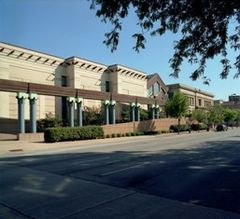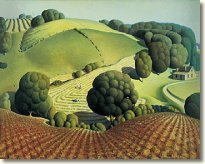
Museum of Art Cedar Rapids
Encyclopedia

Iowa
Iowa is a state located in the Midwestern United States, an area often referred to as the "American Heartland". It derives its name from the Ioway people, one of the many American Indian tribes that occupied the state at the time of European exploration. Iowa was a part of the French colony of New...
, USA. The museum is privately owned and was established in 1905 The museum acquired the old Cedar Rapids Public Library building after the library moved into a new location in 1980. In 1989 the current home of the museum was built adjoining the old library.
The mission of the Cedar Rapids Museum of Art is to excite, engage, and educate its community and visitors through its collection, exhibitions, and programs.
Collection

Marvin Cone
Marvin Dorwart Cone was an American painter in the regionalist style.He was born in Cedar Rapids, Iowa and lived there most of his life. He graduated from Washington High School in 1910. Cone attended college and traveled to Paris with his contemporary and high-school friend, Grant Wood...
, works by Mauricio Lasansky and the Riley Collection of ancient Roman portrait busts. The Grant Wood
Grant Wood
Grant DeVolson Wood was an American painter, born four miles east of Anamosa, Iowa. He is best known for his paintings depicting the rural American Midwest, particularly the painting American Gothic, an iconic image of the 20th century.- Life and career :His family moved to Cedar Rapids after his...
collection includes his paintings “Woman with Plants” and “Young Corn.” In 2002, the CRMA was given the building that houses the original studio of Grant Wood. Located just three blocks from the Museum, the loft studio, known by its fictitious address of 5 Turner Alley, was designed and constructed by Wood, who lived and worked there between 1924 and 1935. It was here that he painted American Gothic
American Gothic
American Gothic is a painting by Grant Wood, in the collection of the Art Institute of Chicago. Wood's inspiration came from a cottage designed in the Gothic Revival style with a distinctive upper window and a decision to paint the house along with "the kind of people I fancied should live in that...
(1930)—now part of the collection of the Art Institute of Chicago
Art Institute of Chicago
The School of the Art Institute of Chicago is one of America's largest accredited independent schools of art and design, located in the Loop in Chicago, Illinois. It is associated with the museum of the same name, and "The Art Institute of Chicago" or "Chicago Art Institute" often refers to either...
—and many of his most famous paintings. The Grant Wood Studio is open to the public for guided tours several days per week.
The Marvin Cone
Marvin Cone
Marvin Dorwart Cone was an American painter in the regionalist style.He was born in Cedar Rapids, Iowa and lived there most of his life. He graduated from Washington High School in 1910. Cone attended college and traveled to Paris with his contemporary and high-school friend, Grant Wood...
collection includes many of his best known landscapes and abstracts. Cone was a collaborator and friend of Grant Wood.
The museum also includes significant pieces by Mauricio Lasansky, Ann Royer
Ann Royer
Ann Royer is a painter and sculptor living and working in Cedar Rapids, Iowa. Her work consists mostly of abstract nudes and horses. She was born in Sioux City, Iowa in 1933.-Education and work:...
, and many others.
Flood 2008


